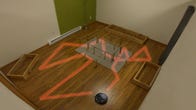It used to be that robot vacuums were only found in Jetsons-like midcentury dream homes or the pages of science fiction. Now they’re real, everyday appliances that can take charge of your housekeeping and many boast features including sophisticated sensors, lasers, CPUs and AI-enhanced software.
If you’re having trouble justifying the cost of a robot vacuum to keep your home tidy, or you’re not sure if you’re ready to replace a perfectly good upright vacuum or cordless model, know that these machines have suction power that will pick up even small bits of debris like cat litter and dust bunnies. Robot cleaners are becoming a smart home staple, with some robotic vacuum brands introducing robot mop models as well. The best robot vacuums are versatile, too: Depending on the cleaning mode, they can keep bare floors like hardwood and tile, area rugs and carpets spick-and-span with powerful suction that, in some cases, rivals that of upright vacuums. Even better, if you tuck the charging dock in an out-of-the-way space, you’ll only have to think about your robot vacuum when you clean its brushes and empty it — you just have automatic dirt disposal and a clean floor. Self-emptying robot vacuum demand is also on the rise, so there are newer models where you have to clear debris from the bin even less of the time.
As cool as they are, robot vacs can set you back more than a traditional vacuum: Some higher-end models cost as much as four figures. While you don’t have to spend that much, you do get a lot in return at those higher price tiers. That includes those self-emptying dustbins, the ability to map multiple rooms and floor plans, powerful cleaning and suction power and thoughtfully designed hardware. None of these machines can truly replace a mop and human exertion on a hard floor that’s truly dirty, so think of them as day-to-day maintenance bots that elevate the baseline cleanliness of your home.
I spent over 120 hours torture-testing a group of 12 robotic vacuums, evaluating them for suction power, their ability to perform on carpets, hardwood floor and other hard flooring types, targeted spot cleaning and performance during each cleaning cycle. Among them are brand-new models that launched in 2021, flagship models from companies like iRobot, Samsung and Neato and compelling options offered across numerous online retailers. I excluded older models that likely won’t be sold for much longer. I’ll continue to update this best robot vacuum list periodically as new models become available, so you can find the best vacuum for your home.

 \n ","topic":"","ttag":"","variant":"","viewguid":"","event":"listicle|image|1","correlationId":"","_destCat":"https:\/\/goto.target.com\/c\/159047\/81938\/2092?&sharedId=cnet&u=https%3A%2F%2Fwww.target.com%2Fp%2Firobot-roomba-s9-wi-fi-connected-self-emptying-robot-vacuum-black-9550%2F-%2FA-76551040&subId1=[subid_value]","productName":"The best robot vacuum: iRobot Roomba S9 Plus","formatType":"IMAGE","location":"LIST","position":1,"sku":"S955020","dwLinkTag":"article-body|listicle|image","selector":"#article-body #listicle-311cf7c5-6430-41ff-baf1-2646fb14ca35 .itemImage"}}” rel=”noopener nofollow” target=”_blank”>
\n ","topic":"","ttag":"","variant":"","viewguid":"","event":"listicle|image|1","correlationId":"","_destCat":"https:\/\/goto.target.com\/c\/159047\/81938\/2092?&sharedId=cnet&u=https%3A%2F%2Fwww.target.com%2Fp%2Firobot-roomba-s9-wi-fi-connected-self-emptying-robot-vacuum-black-9550%2F-%2FA-76551040&subId1=[subid_value]","productName":"The best robot vacuum: iRobot Roomba S9 Plus","formatType":"IMAGE","location":"LIST","position":1,"sku":"S955020","dwLinkTag":"article-body|listicle|image","selector":"#article-body #listicle-311cf7c5-6430-41ff-baf1-2646fb14ca35 .itemImage"}}” rel=”noopener nofollow” target=”_blank”>
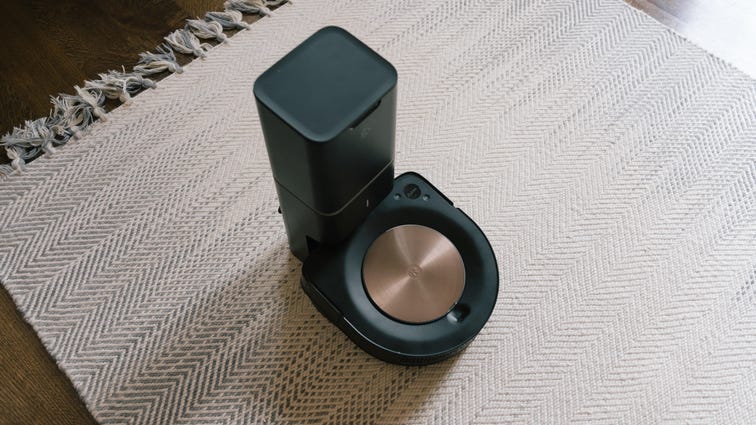

Tyler Lizenby/CNET
If someone gave you a blank check and told you to buy the best robot vacuum, this would be the robot vac to get. Roomba vacuums are extremely popular, and this is my pick for the best Roomba of them all. That said, the iRobot Roomba S9 Plus has a whopping price tag: $1,100 (though sometimes it’s discounted). For that staggering amount of money, this robotic vacuum delivers powerful suction and superb dirt and dust removal. It’s one of the best robot vacuums you can get if money isn’t a concern.
On hardwood floors this Roomba picked up an average of 93% of our test sand, the second-highest amount in our test group. With 95% sand removal, the Neato Botvac D7 still reigns supreme on that test. Its performance on carpets was disappointing though. It managed 36% on low-pile and 47% on midpile carpets.
The Roomba S9 Plus also struggled a bit cleaning sand from low-pile carpeting, earning a low average dust and sand pickup of 28%. While not the worst result we’ve seen (that honor belongs to the Ecovacs Deebot 600 at 18%), it’s definitely near the bottom.
That said, the Roomba S9 Plus removed an average 71% of sand from our medium pile carpet while vacuuming, which is the best result that we’ve seen on this specific test. It also cleaned up more dog hair, pet dander and allergens than any other vacuum in this test group. The S9 Plus can navigate and map multiple rooms and floors, while avoiding “keep-out zones” that you can designate. The app also lets you use Alexa or Google Assistant commands to tell it to begin cleaning a room. You can link the S9 Plus to your home Wi-Fi as well.
The robot zipped through our test room in a short average time of 25 minutes, too. Best of all is the Roomba S9 Plus’ CleanBase docking station. The dock both charges the robot’s battery and empties its dustbin automatically, making cleaning even easier and keeping you from worrying about battery life. Now that’s convenient.

 \n ","topic":"","ttag":"","variant":"","viewguid":"","event":"listicle|image|2","correlationId":"","_destCat":"https:\/\/www.amazon.com\/Roborock-S7-Mopping-Auto-Empty-Multi-Level\/dp\/B08VHXZZ22","productName":"The best midrange robot vacuum: Roborock S7","formatType":"IMAGE","location":"LIST","position":2,"sku":"S7","dwLinkTag":"article-body|listicle|image","selector":"#article-body #listicle-a05e6f38-1839-437d-97a2-9d8e94d2228e .itemImage"}}” rel=”noopener nofollow” target=”_blank”>
\n ","topic":"","ttag":"","variant":"","viewguid":"","event":"listicle|image|2","correlationId":"","_destCat":"https:\/\/www.amazon.com\/Roborock-S7-Mopping-Auto-Empty-Multi-Level\/dp\/B08VHXZZ22","productName":"The best midrange robot vacuum: Roborock S7","formatType":"IMAGE","location":"LIST","position":2,"sku":"S7","dwLinkTag":"article-body|listicle|image","selector":"#article-body #listicle-a05e6f38-1839-437d-97a2-9d8e94d2228e .itemImage"}}” rel=”noopener nofollow” target=”_blank”>
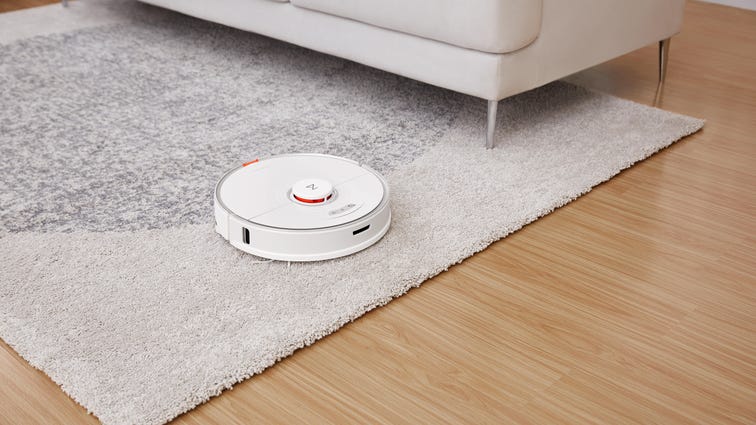

Roborock
With a competitive price, plus rock-solid performance and intelligent navigation, the Roborock S7 is our new favorite midrange robot vacuum. It demonstrated about the same power to remove sand from hardwood floors (92.8%) as the Roomba S9 Plus (93%) and Neato D7 (95%).
However, unlike the Neato D7, our previous midrange robot vacuum pick, the Roborock S7 was much more effective at pulling sand away from both medium-pile (50.4%) and low-pile carpets (64.2%). The Neato D7 managed 36% and 47% on those tests respectively.
The Roborock couldn’t match the Roomba S9 Plus’ impressive ability to clean up pet hair, but it fared better than most. The S7 wiped hardwood floors completely free of hair and left only a few stray tufts on carpeting.
Aided by multiple sensors and lasers, efficient navigation is the S7’s strong suit. The vacuum cleaner covered the entire floor of our test room in an average of just 16 minutes. That’s a full 9 minutes shorter than the Roomba S9 Plus required (25 minutes).
Another feature that sets this robot mop vacuum apart is its advanced mopping capability. Just fill the machine’s reservoir with water, then attach the included mopping pad. The S7 will now mop the floor on command.
It can even mop and vacuum carpets within the same cleaning run by raising and lowering its mopping pad. To do this it first performs a mapping run to locate where your carpets are. The robot mop vacuum then uses sensors to confirm the presence of carpeting where it expects to find it.

 \n ","topic":"","ttag":"","variant":"","viewguid":"","event":"listicle|image|3","correlationId":"","_destCat":"https:\/\/www.amazon.com\/EUFY-Robovac-25C-Robot-Vacuum\/dp\/B07RFNTVSF","productName":"Best budget robot vacuum: Eufy RoboVac 25C (Update: Currently unavailable)","formatType":"IMAGE","location":"LIST","position":3,"sku":"AK-T2102111","dwLinkTag":"article-body|listicle|image","selector":"#article-body #listicle-7fd07eab-92cf-4225-a97d-d8caba2de245 .itemImage"}}” rel=”noopener nofollow” target=”_blank”>
\n ","topic":"","ttag":"","variant":"","viewguid":"","event":"listicle|image|3","correlationId":"","_destCat":"https:\/\/www.amazon.com\/EUFY-Robovac-25C-Robot-Vacuum\/dp\/B07RFNTVSF","productName":"Best budget robot vacuum: Eufy RoboVac 25C (Update: Currently unavailable)","formatType":"IMAGE","location":"LIST","position":3,"sku":"AK-T2102111","dwLinkTag":"article-body|listicle|image","selector":"#article-body #listicle-7fd07eab-92cf-4225-a97d-d8caba2de245 .itemImage"}}” rel=”noopener nofollow” target=”_blank”>
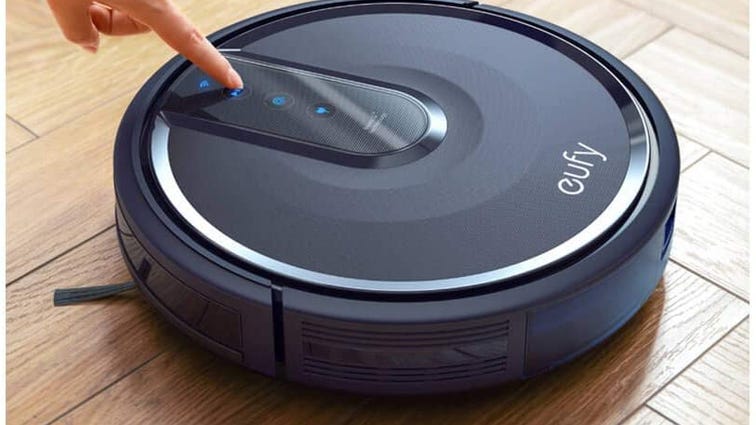

Amazon
You might not expect sufficient cleaning power from a budget robot vacuum, but that’s precisely what the Anker Eufy RoboVac 25C delivers. Its suction power ability to scour sand from hardwood floors (78.9%) wasn’t too far below that of the Roborock S7. The Eufy RoboVac 25C’s sand performance across low-pile (53.5%) and medium-pile (52.2%) carpets was decent as well.
This robot also wasn’t too bad at dealing with pet hair. It pulled all save one tuft from our hardwood test floor. Multiple small tufts of hair remained after vacuuming low-pile carpeting. Medium-pile carpets proved to be the most challenging for the Eufy. Many more and larger clumps of hair stayed behind after the vacuum traveled over this surface.
One area where Anker cut down on costs is the RoboVac’s navigation system. The machine bumps around the floor like a slow-motion ping-pong ball, changing direction when it encounters an object or obstacle. As a result it took a long 91 minutes to finish its cleaning cycle in our test room.

 \n ","topic":"","ttag":"","variant":"","viewguid":"","event":"listicle|image|4","correlationId":"","_destCat":"https:\/\/www.anrdoezrs.net\/click-3586864-15111545-1637730001000?sid=[subid_value]","productName":"The best poop-avoiding robot vacuum: iRobot Roomba J7 Plus","formatType":"IMAGE","location":"LIST","position":4,"sku":"","dwLinkTag":"article-body|listicle|image","selector":"#article-body #listicle-e82339a6-b445-493b-845a-3c070dd55eed .itemImage"}}” rel=”noopener nofollow” target=”_blank”>
\n ","topic":"","ttag":"","variant":"","viewguid":"","event":"listicle|image|4","correlationId":"","_destCat":"https:\/\/www.anrdoezrs.net\/click-3586864-15111545-1637730001000?sid=[subid_value]","productName":"The best poop-avoiding robot vacuum: iRobot Roomba J7 Plus","formatType":"IMAGE","location":"LIST","position":4,"sku":"","dwLinkTag":"article-body|listicle|image","selector":"#article-body #listicle-e82339a6-b445-493b-845a-3c070dd55eed .itemImage"}}” rel=”noopener nofollow” target=”_blank”>
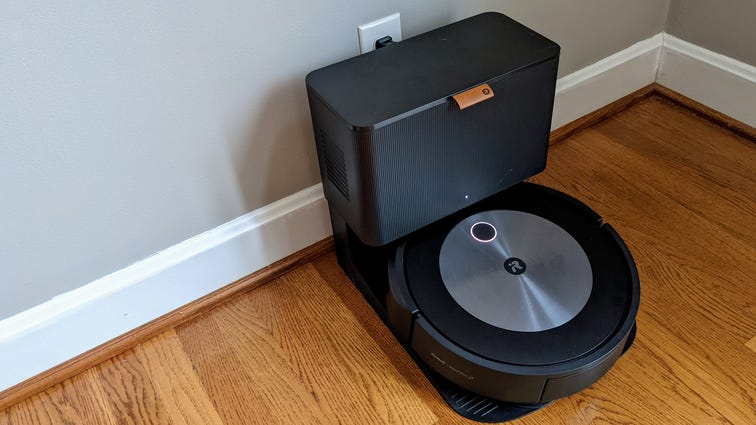

Brian Bennett/CNET
Solid pet waste and robot vacuums don’t mix. If they do, the results have typically been catastrophic. iRobot set out to solve this potential problem with its new Roomba J7 Plus. This robot’s software is designed to enable it to recognize solid pet waste on the floor and steer clear of it.
Anecdotal lab tests confirmed the J7’s waste avoidance capabilities. The robot smoothly cleaned open areas within the confines of a test pen and never touched any of our solid pet waste facsimiles. We used three pieces of prank dog poop, all of different shapes, to represent the offensive substance.
Another robot vacuum, the Jet Bot AI Plus, is also billed as being able to avoid pet waste. Unfortunately, the robot consistently failed to recognize one out of our three gag poop objects. It wouldn’t just briefly touch the item either. Often the machine would push the piece of fake poop from one end of our test pen to the other. That’s a recipe for poopocalypse in the real world.
The Roomba J7 performed relatively well on hardwood and low-pile carpets, removing 91.7% and 58.5% of test sand from those surfaces respectively. However, the robot struggled while vacuuming medium pile carpeting, pulling away just 17% of sand here.
Keeping a constant eye out for pet waste didn’t seem to slow the Roomba J7 down. The robot successfully covered our test room in just 17 minutes. Pet hair on carpets wasn’t much of an issue for the Roomba either. Hair on hardwood was a problem, however. This Roomba robot vacuum left about half of the material on the floor during this test.
Like its more expensive sibling the Roomba S9 Plus, the J7 Plus can empty its own dustbin. The robot’s CleanBase docking station both charges it and vacuums it free of debris automatically.
The chart below shows fine-particle cleaning performance data for all of the robot vacuums we tested. It should give you a pretty good idea of their cleaning performance on different kinds of flooring surfaces, including hardwood floors, bare floors and low-pile carpet. Our rice-based, medium-size particle test didn’t show much differentiation between the robot cleaners because they can all handle larger particles without trouble. For fur removal for pet owners, we judged anecdotally. To learn about our cleaning power and navigation tests, read more about how we test robot vacuums.
Percent sand removed
iRobot Roomba S9 Plus
Roborock S7
Samsung Samsung Jet Bot AI Plus
iRobot Roomba J7 Plus
Anker Eufy Robovac 25C
Neato Botvac D7 Connected
Neato Botvac D4 Connected
Electrolux Pure i9
Neato Botvac D6 Connected
RoboRock S5 Max
Ecovacs Deebot Ozmo 950
Shark IQ 1001AE
iRobot Roomba i7 Plus
Eufy RoboVac 11s Max
Ecovacs Deebot 600
Ecovacs Deebot 500
Legend:
From low-pile carpet
From hardwood carpet
From medium-pile carpet
Note:
Results listed are the average percentage of total material removed from test surface
Want more robot vacuum cleaner options? Here’s a list of the other robot vacuums we tested besides the models listed above.
Robot vacuum FAQs
How do robot vacuums work?
Designed to navigate your home and clean your floors automatically, robot vacuum cleaners are made to tackle this chore so you don’t have to. They can clean on demand, on a schedule and even when you’re not home. Powered by rechargeable batteries, the robot typically sits on a charging dock to top off its energy supply. Premium models come with docking stations that can also empty the robot’s dustbin when it’s full.
How long do robot vacuums last?
Robot vacuums are complex machines with more moving parts, electronics and software than ordinary vacuums. Still, with regular maintenance and replacement parts such as batteries, brushes and filters, these devices can last just as long as traditional vacuums. This should translate to multiple years of use.
Keep in mind that manufacturers typically cover their robots with one-year limited warranties that include parts and labor. IRobot, Neato, and Samsung are examples.
How well do robot vacuums work?
How well a robot vacuum cleans your home depends on many factors. Floors cluttered with obstacles like wires, charging cords, toys, shoes and clothing can stop robots in their tracks. The less overall clutter the better a robot will operate. Some robot vacuum models clean tile, wood flooring and different types of carpet better than others.
